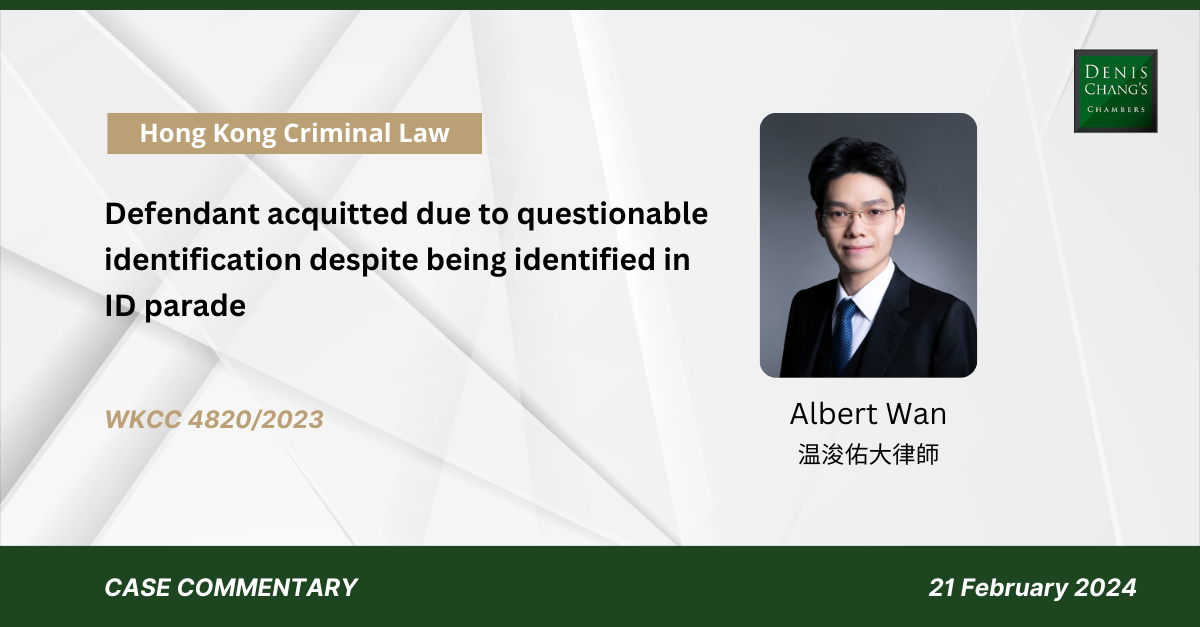
Defendant acquitted due to questionable identification despite being identified in ID parade
Hong Kong Criminal Law
On 20 February 2024, Deputy Magistrate Erica Chong Ching-wai acquitted the Defendant on one charge of common assault. Albert Wan acted for the Defendant in HKSAR v Wong Oi Chung (WKCC 4820/2023).
The Prosecution’s Case
The Defendant was charged with common assault against PW1, contrary to common law and punishable under section 40 of the Offences against the Person Ordinance (Cap 212).
On 6 April 2023, PW1 was attacked by a male who was wearing cap and face mask from behind with a glass bottle while PW1 was crossing the road outside Golden Era Plaza. PW1 stated that he recognized the male who attacked him was his ex-employee (the Defendant). There was an incident on 22 March 2023, the Defendant quitted the job on the same day. Subsequently, an ID Parade was held and PW1 identified the Defendant as the male who assaulted him.
The Defence’s Case
It is the Defence’s case that the Defendant was mistakenly identified by PW1. The Defence cited the English Court of Appeal decision in R v Turnbull [1977] QB 224 as authority for the following propositions:
(1) A mistaken witness can be a convincing one and that some such witnesses can all be mistaken.
(2) When considering the identification evidence, the court should examine carefully the circumstances in which the identification by each witness came to be made, for example, how long did the witness have the accused under observation, was the observation impeded in any way, etc.
(3) Even when the witness is purporting to recognise someone whom he knows, mistakes in recognition of close relatives and friends are sometimes made.
(4) When the quality of the identifying evidence is weak, for example when it depends on a fleeting glance, the defendant must be acquitted unless there is other evidence which goes to support the correctness of identification.
Applying to the present case, PW1’s identification evidence is weak as it depends on a fleeting glance:
(1) First, as can be seen in the CCTV footage of Golden Era Plaza, after PW1 was attacked from behind, he turned and the male who attacked PW1 turned and ran away. PW1 could only observe the face of the male for a very short period of time.
(2) Second, PW1’s observation was impeded by the face mask and cap worn by the male. PW1 could only observe the male’s eyes.
The Defence thus submitted that there is reasonable doubt as to the identification.
In respect of PW1’s credibility, the Defence submitted that PW1 is not a credible witness as there were various discrepancies between his testimony in court and his statement taken by the police; and there was a change of evidence when he was testifying in court.
In respect of the Defendant’s evidence, the Defence submitted the Defendant is a credible witness. The Defendant testified that he stayed at home the whole day on 6 April 2023, which is consistent with what he said under cautioned after being arrested by the police.
In respect of the incident on 22 March 2023, there was an argument between PW1 and the Defendant. the Defendant resigned. During the argument, PW1 threw a bowl at the Defendant. The Defendant made a report to the police. Under the conciliation by the police, PW1 pay the Defendant salary for that month and allow the Defendant to quit the job immediately. The Defence submitted that the fact that the Defendant chose to make a report to the police reflected that the Defendant would use lawful means to resolve disputes with PW1. From the Defendant’s point of view, the dispute has been resolved. On the other hand, PW1 may hold a grudge against the Defendant after this incident and thus fabricate the identification.
The Court’s Findings
The learned Magistrate acquitted the Defendant on the ground that the Prosecution has failed to prove beyond reasonable doubt that the Defendant was the person who attacked PW1:
(1) In respect of the identification evidence, the learned Magistrate viewed the CCTV footage of Golden Era Plaza and saw that when PW1 turned around to see who attacked him, the male also turned. PW1 could only observe the side of the male for a short period of time. PW1 may be mistaken about the identity of the male who attacked him.
(2) In respect of PW1’s credibility, PW1 confirmed the Defendant reported to the police on 22 March 2023; but claimed that there was no argument between him and the Defendant. The learned Magistrate held that PW1 did not reveal the whole truth to the Court.
(3) In respect of the Defendant’s evidence, the learned Magistrate accepted the Defendant’s evidence may be true. the Defendant said he stayed at home on the offence date. When the Defendant quitted the job on 22 March 2023, the Defendant requested to terminate the employment; he received salary from PW1; he did not have to pay in lieu of notice; he was allowed to terminate employment immediately. There was no motive for the Defendant to attack PW1.
Albert Wan

Albert accepts instructions for both advocacy and advisory work, and has been instructed on matters covering a wide range of areas of law. His practice covers general civil, land, building management, company, probate, contract, tort, commercial, construction, bankruptcy, personal injuries, judicial review and election petition.
Outside of his practice, Albert is a part-time law lecturer, contributing author for the Lexis Advance Hong Kong Practical Guidance, a member of the Standing Committee on Legal Aid Reform of the Hong Kong Bar Association and a participating lawyer in the Duty Lawyer Service Free Legal Advice Scheme.
Before he joined the bar, Albert obtained a Master of Law at University of Cambridge and Bachelor of Laws at City University of Hong Kong with First Class Honours. Find out more from Albert’s profile.
This article was first published on 15 March 2024.
Disclaimer: This article does not constitute legal advice and seeks to set out the general principles of the law. Detailed advice should therefore be sought from a legal professional relating to the individual merits and facts of a particular case. The photographs which appear in this article are included for decorative purposes only and should not be taken as a depiction of any matter to which the case is related. The views and opinions expressed in this article/material are solely those of the members authoring it and do not necessarily reflect the official policy or position of Denis Chang’s Chambers, or of any other member or members of Denis Chang’s Chambers.